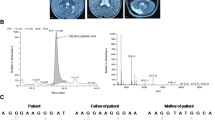Abstract
l-2-Hydroxyglutaric aciduria (l-2-OHGA) is a rare autosomal recessive inherited encephalopathy. This inborn error, characterized by psychomotor retardation, progressive ataxia and typical magnetic resonance imaging findings, presents in early infancy. To make a definitive diagnosis, an anomalous accumulation of l-2-hydroxyglutaric acid must be detected in body fluids. Here, we present a 17-year-old boy with l-2-OHGA who developed an anaplastic ependymoma during the course of this disease. We also present a literature review including seven other patients who developed malignant brain tumors during the course of l-2-OHGA. This correlation may indicate a possible increased risk of brain tumors among patients with l-2-hydroxyglutaric aciduria.


Similar content being viewed by others
References
Duran M, Kamerling JP, Bakker HD, van Gennip AH, Wadman SK (1980) l-2-Hydroxyglutaric aciduria: an inborn error of metabolism? J Inherit Metab Dis 3:109–112. doi:10.1007/BF02312543
D’Incerti L, Farina L, Moroni I, Uziel G, Savoiardo M (1998) l-2-hydroxyglutaric aciduria: MRI in seven cases. Neuroradiology 40:727–733. doi:10.1007/s002340050673
Moroni I, D’Incerti L, Farina L, Rimoldi M, Uziel G (2000) Clinical, biochemical and neuroradiological findings in l-2-hydroxyglutaric aciduria. Neurol Sci 21:103–108. doi:10.1007/s100720070104
Warmuth-Metz M, Becker G, Bendszus M, Solymosi L (2000) Spinal canal stenosis in l-2-hydroxyglutaric aciduria. Arch Neurol 57:1635–1637. doi:10.1001/archneur.57.11.1635
Chen E, Nyhan WL, Jakobs C et al (1996) l-2-Hydroxyglutaric aciduria: neuropathological correlations and first report of severe neurodegenerative disease and neonatal death. J Inherit Metab Dis 1:335–343. doi:10.1007/BF01799264
Barth PG, Hoffmann GF, Jaeken J et al (1992) l-2-Hydroxyglutaric acidemia: a novel inherited neurometabolic disease. Ann Neurol 32:66–71. doi:10.1002/ana.410320111
Wileken B, Pitt J, Heath D, Walsh P, Wilson G, Buchanan N (1993) l-2-Hydroxyglutaric aciduria: three Australian cases. J Inherit Metab Dis 16:501–504. doi:10.1007/BF00711665
Barbot C, Fineza I, Diego L, Maia M, Melo J, Guimaraes A et al (1997) l- 2- Hydroxyglutaric aciduria: clinical, biochemical and magnetic resonance imaging in six Portuguese pediatric patients. Brain Dev 19:268–273. doi:10.1016/S0387-7604(97)00574-3
Osizik PA, Akalan N, Palaoglu S, Topcu M (2002) Medulloblastoma in a child with the metabolic disease l-2-hydroxyglutaric aciduria. Pediatr Neurosurg 37:22–26. doi:10.1159/000065097
Moroni I, Bugiani M, D’Incerti L, Maccagnano C, Rimoldi M, Bissola L, Pollo B, Finocchiaro G, Uziel G (2004) l-2-hydroxyglutaric aciduria and brain malignant tumors: a predisposing condition? Neurology 62(10):1882
Frost EE, Nielsen JA, Le TQ, Armstrong RC (2003) PDGF and FGF2 regulate oligodendrocyte progenitor responses to demyelination. J Neurobiol 54:457–472. doi:10.1002/neu.10158
Okamoto H, Mineta T, Nakahara Y, Ichinose M et al (2004) Molecular analysis of astrocytoma associated with Turcot syndrome type 1-case report. Neurol Med Chir (Tokyo) 44(3):124–128. doi:10.2176/nmc.44.124
Theodoropoulou M, Arzberger T, Gruebler Y, Jaffrain-Rea ML (2004) Expression of epidermal growth factor receptor in neoplastic pituitary cells: evidence for a role in corticotropinoma cells. J Endocrinol 183(2):385–394. doi:10.1677/joe.1.05616
Lurie DI, Solca F, Fischer EH, Rubel EW (2000) Tyrosine phosphatase SHP-1 immunoreactivity increases in a subset of astrocytes following deafferentation of the chicken auditory brainstem. J Comp Neurol 421(2):199–214. doi:10.1002/(SICI)1096-9861(20000529)421:2<199::AID-CNE6>3.0.CO;2-G
Author information
Authors and Affiliations
Corresponding author
Rights and permissions
About this article
Cite this article
Aghili, M., Zahedi, F. & Rafiee, E. Hydroxyglutaric aciduria and malignant brain tumor: a case report and literature review. J Neurooncol 91, 233–236 (2009). https://doi.org/10.1007/s11060-008-9706-2
Received:
Accepted:
Published:
Issue Date:
DOI: https://doi.org/10.1007/s11060-008-9706-2




